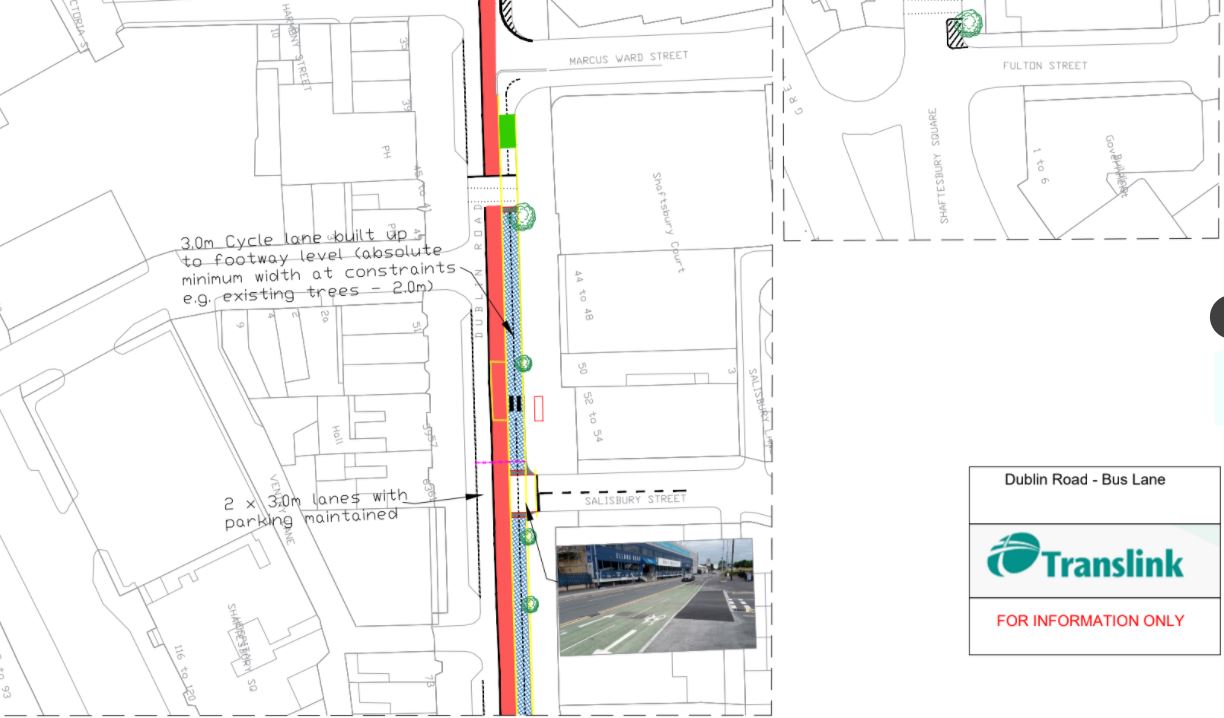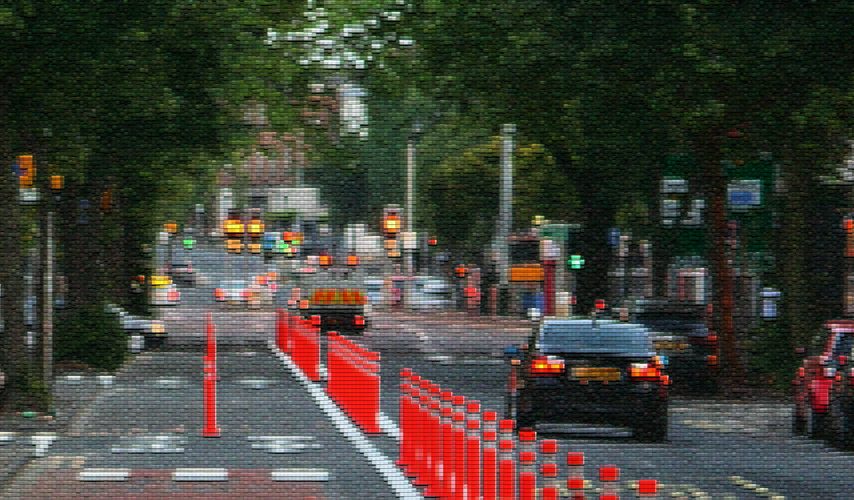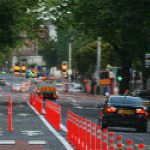Translink’s response ten days ago to an information request, reporting that it held no information on the Dublin Road cycleway, has been thrown into serious confusion by a response from the Department for Infrastructure (DfI) to a parallel request, which details months of lobbying by Translink to have the same cycleway removed, or reconfigured to allow vehicle access into it.
Documents show that from at least May 2021 Translink staff have been pushing hard for the removal of the cycleway, committing significant staff time in various endeavours, such as:
- meetings on-site with DfI staff
- screen-grabbing city-wide bus delays data claiming to show “traffic congestion being caused because of Dublin Road and Bruce Street“
- screen-grabbing traffic cameras showing stills of congestion
- working up engineering designs for alternative layouts
- compiling a seven page “review of the impact of Pop-Up cycle lanes in Belfast“
- engaging staff to conduct on-site counts of cycle users of the Dublin Road and Grosvenor Road cycleways
- concluding that the “immediate removal of pop-up cycle lanes” is recommended
This is in spite of Translink’s very clear response to us on 10 September 2021 that they “do not hold the information specified in your request” regarding any:
- internal documents and records
- external correspondence
- meeting documents
- consultation responses
- any records of conversations between staff and DfI
- any data collected on the cycle lane (and the rationale and methodology should such data exist)
The seven page review document sent to DfI in June, which Bikefast understands will feed into DfI’s own review of the temporary cycleway, claims the cycleway is impacting on bus reliability.
“It is evident that the pop-up cycle lanes are severely impacting on the timelines and reliability of the services provided and a disproportionate impact on the customers travelling to the South of the city.”
Translink review of the impact of Pop-Up cycle lanes in Belfast
Given Translink’s statement in our previous article that it is “fully committed to active and sustainable travel solutions“, the conclusion in their review is staggering:
“In the immediate term it is recommended that option 3 [Immediate removal of pop-up cycle lanes and work to replace with sustainable transport lanes, facilitating cyclists and buses (including bus passengers/pedestrians) who choice to travel to/from the city centre using sustainable modes] is considered as the most viable short-term solution that will benefit a significant number of passengers/pedestrians who choice to travel sustainably to /from city centre. It is acknowledged that this is not an optimum solution for the very small numbers of cyclists using the citybound pop up cycle lane, however it is evident that there will be a net benefit to the broader sustainable transport family.”
Translink review of the impact of Pop-Up cycle lanes in Belfast (our emphasis)
Cycle Infrastructure Design Local Transport Note 1/20 (LTN 1/20) is clear that bus lanes “do not provide an environment attractive to a wide range of people and should therefore not be regarded as inclusive“, and Translink’s option would completely remove the option for safe, protected cycling from Shaftesbury Square to the city centre.
(Aside – Translink’s “mid to longterm” suggested solution is to plough another vehicle lane along Dublin Road (cycleway / bus lane / vehicle lane / vehicle lane) at the expense of all on-street parking – cutely sidestepping their part in the street fight to allow local businesses and cycling advocates to duke it out for years to come.)
As part of its lobbying efforts, Translink even went as far as having its “mobile inspectorate team” undertake visual recording of Belfast’s pop-up cycle lane users for eight and a half hours over six days in May and June. A total of just five bicycle users were observed using the lanes during these periods, according to staff employed by the organisation pushing for the immediate removal of pop-up cycle lanes.
“Observations in respect to pop cycle lanes usage undertaken by our mobile inspectorate teams points to extremely low usage, with maximum observed usage of 3 in the AM peak between 0800-0930.”
Translink review of the impact of Pop-Up cycle lanes in Belfast
The use of plural (lanes, not lane) in the Translink review is possibly of note, given that two of the eight observation periods were actually conducted on the Grosvenor Road cycleway, which runs from the Royal Victoria Hospital to the site of Translink’s forthcoming multi-modal Transport Hub. In terms of operational impact, it appears from timetables that the only services directly affected by this cycleway are the 10k and 10m which operate just 31 citybound services on a weekday, at a rate of just two per hour from 8am onwards. Is Translink lobbying to have the Grosvenor Road cycleway removed too?
In early July it appears that DfI agreed a change to the street layout on Dublin Road, based on a return to two vehicle lanes (while retaining the two-way cycleway with a view to making it permanent, pending review) and that the reinstated vehicle lane should be a dedicated bus lane, which would be an upgrade on the pre-coronavirus situation for bus priority.
“DFi will work up a scheme which reduces width of cycle lane and allows for introduction of 2 running lanes. Recommend a proposal for a pop up bus lane, and general traffic lane.”
Email to DfI from Translink in July 2021, summarising a meeting outcome
However Translink continued to lobby DfI on issues with the cycleway into August, its impact on bus services, and including offering design input into the proposed permanent re-arrangement.

This suggested a minimum 3 metre cycleway “raised at footway level” could be retained “in accordance with LTN 1/20“. And yet from the suggested design notations (above) it appears the slightly shifted cycleway would now include trees, parking meters and a BT advertising / WiFi station as obstacles, narrowing to 2 metres at these “constraints“.
This submission concluded with another jaw-dropping statement:
“Consideration will need to be given to servicing of the businesses on the left‐hand side along Dublin Road. To minimise conflict, a dropped kerb could be included along the cycle lane to allow limited access for vehicles to load/unload from the cycle lane.”
Email to DfI from Translink in August 2021 (our emphasis)
It is remarkable to see the such sub-standard and out-of-date design ideas being pushed for, when LTN 1/20 is referenced in the same email – as that document is quite clear:
“6.4.18 Cycle lanes are only useful when they are clear of parking and loading activity. Cycle lanes should always be kept clear by the appropriate use of parking and loading restrictions. This is particularly important wherever demand for kerbside access is high, for example in town centres.”
Cycle Infrastructure Design Local Transport Note 1/20
(Aside – perhaps, given there never was a bus lane on Dublin Road pre-pandemic, such loading activities could be conducted from the new bus lane, as a compromise worthy of Translink’s commitment to “active and sustainable travel solutions”?)

The dissatisfying bus stop arrangement (as amended) on Dublin Road (Google Streetview)
Disabled users of the Dublin Road bus stop and cycle lane may not be surprised to hear that their needs were not advocated for in any of the correspondence seen between Translink and DfI. Perhaps the review into our Translink information request may dredge up something, but it is remarkable that no record has been sent of any back-and-forth on the initial bus stop design, nor the amended version – both unsatisfactory layouts for all users, but especially those with visual and mobility impairments. Indeed, a careful look at Translink’s suggested redesign (above) shows the same zebra crossing set-up as today.
We asked Translink for comment on this article, to confirm whether on not their current position is for removal of the cycle lanes on Dublin Road and Grosvenor Road (and if that is the position fed into DfI’s review) and why a nil response was returned on an information request where reams of Translink documents, record and communications clearly exist and have been sent to DfI.
A spokesperson said:
“As per our email of Friday, 10th September, ‘We understand that you have requested an internal review of the response we provided to your recent FOI relating to cycling infrastructure on Belfast’s Dublin Road. The content of your email sent to the press team on Friday 10th Sept will be considered as part of this process’. Today’s email is a new request for information which we have sent to Translink’s Freedom of Information team.”
With various information request reviews ongoing, we expect this story is far from over.



[…] I am a cyclist but the last thing I would ever do is bring my child out on the roads of Belfast. The cycle lane infrastructure in Belfast and throughout Northern Ireland is absolutely pathetic. In Belfast there are only 2 miles of protected cycle lanes in the whole city. The Department Of Cars Infrastructure has done next to nothing to put in proper cycle infrastructure. What little they did do Translink has been lobbying to get removed. […]